#nircam
Photo

Webb Telescope Captures Fiery Formation of New Star
Full Resolution PNG Image (For Display)
Full Resolution TIF Image (For Print)
#astronomy#astrophysics#jwst#james webb space telescope#webb telescope#space#L1527#protostar#new star formation#science#physics#nasa#NIRCam#hourglass formation#nebula
722 notes
·
View notes
Text
Tendrils of NGC 604
The James Webb Space Telescope’s NIRCam and MIRI capture the star-forming region NGC 604. What beautiful images!

NIRCam View
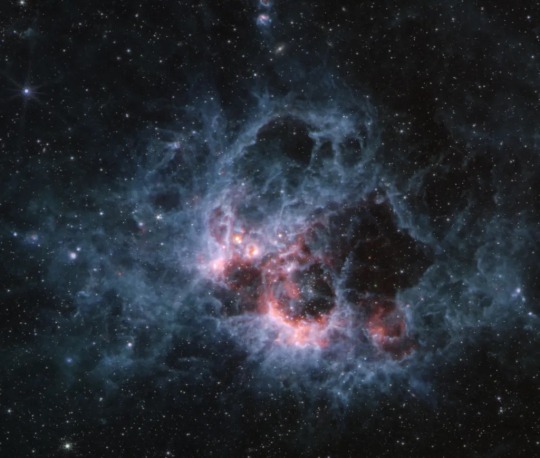
MIRI View
Full NASA article
v v v
#astronomy#nasa news#nasa#nasa photos#james webb space telescope#nircam#miri#ngc 604#space news#space#m33#galaxy#nebula#astronomy news#astrophotography
39 notes
·
View notes
Text
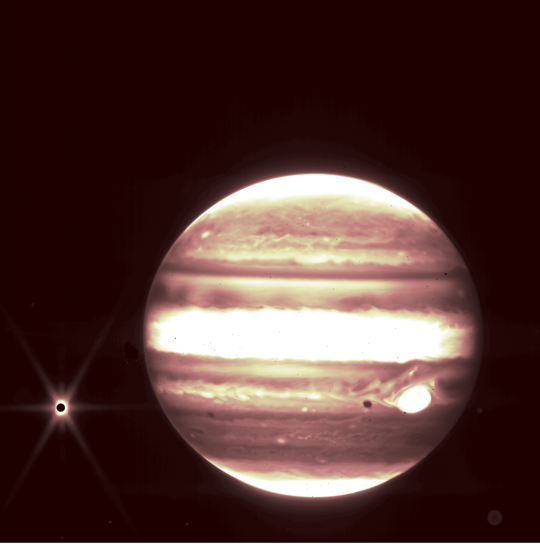
Credits: NASA, ESA, CSA, and B. Holler and J. Stansberry (STScI)
Jupiter, center, and its moon Europa, left, are seen through the James Webb Space Telescope’s NIRCam instrument 2.12 micron filter.
#nasa#space#astronomy#science#astrophotography#jwst#astrophysics#james webb space telescope#jupiter#planet#solar system#infrared#europa#moon#nircam#cosmos#my post#planets#rename jwst#RenameJWST
646 notes
·
View notes
Text



ngc 6822
#jwst#james webb space telescope#ngc 6822#how tho#the universe is just crazy yo#irregular galaxy#barnards galaxy#sagittarius constellation#nircam#ic 4895
11 notes
·
View notes
Text
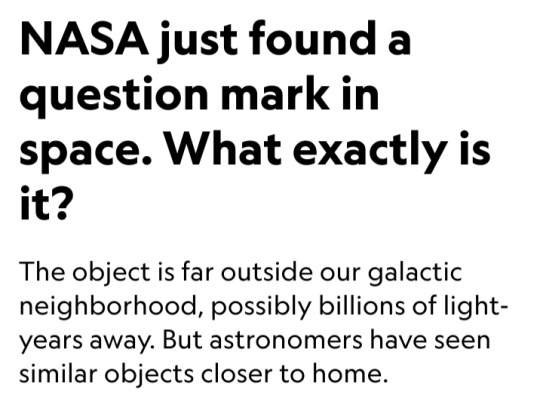
By Allie Yang
10 August 2023

Two of our galaxy’s most famous stars were recently photobombed by what appears to be a celestial question mark.
The symbol was spotted in a new image from the James Webb Space Telescope (JWST) of the forming stars Herbig-Haro 46/47, which are well-known and have been frequently observed by astronomers.
These two stars can provide clues about how our own sun may have formed.
They’re relatively close to Earth, about 1,400 light-years, and relatively young, only a few thousand years old.
In fact, they’re still in gestation and have not technically been “born” yet, which is marked when the stars start shining from their own nuclear fusion.
The image is the first of the twin protostars from the NIRCam instrument on JWST.
It was captured using infrared light, which penetrates space dust more easily than visual light, and it is the highest resolution image of the objects ever seen at these wavelengths.
The telescope’s astonishing sensitivity allowed the glowing red question mark to be captured in the lower center of the image.
The object is far outside our galactic neighborhood, possibly billions of light-years away, says Christopher Britt, an education and outreach scientist at the Space Telescope Science Institute who helped plan these observations.
His best guess is that the question mark is actually two galaxies merging.
“That's something that's seen fairly frequently, and it happens to galaxies many times over the course of their lives,” he says.
“That includes our own galaxy, the Milky Way … [it] will merge with Andromeda in about four billion years or so.”
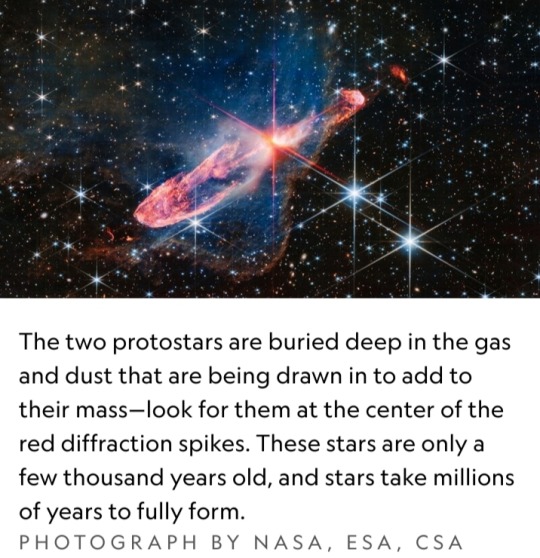
The hints pointing to two galaxies are found in the question mark’s strange shape.
There are two brighter spots, one in the curve and the other in the dot, which could be the galactic nuclei, or the centers of the galaxies, Britt says.
The curve of the question mark might be the “tails” being stripped off as the two galaxies spiral toward each other.
“It's very cute. It's a question mark … But you can find the colons and semicolons, and any other punctuation mark, because you have 10,000 little smudges of light in each image taken every half hour,” says David Helfand, an astronomer at Columbia University.
The sheer number of shining objects we find are bound to create some serendipitous images, and our brains have evolved to find those patterns, he says.
Astronomers have seen similar objects closer to home.
Two merging galaxies captured by the Hubble Space Telescope in 2008 also look like a question mark, just turned 90 degrees.
Helfand says the question mark seems to be two objects, the curve and the dot, but could be more that just happened to line up.
They could also be completely unrelated objects, he says, if one is much closer to Earth than the other.
Britt warns that estimating distance based only on colors in the image can be tricky.
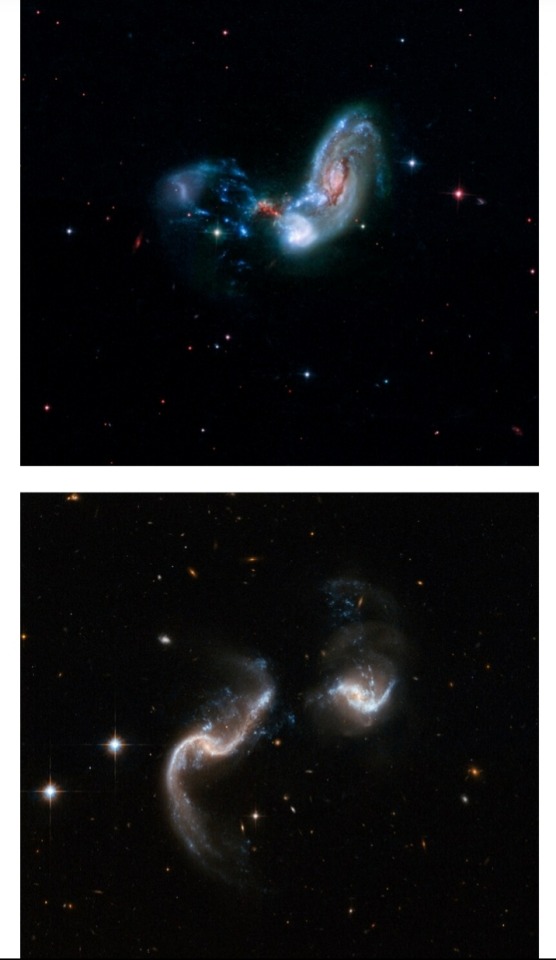
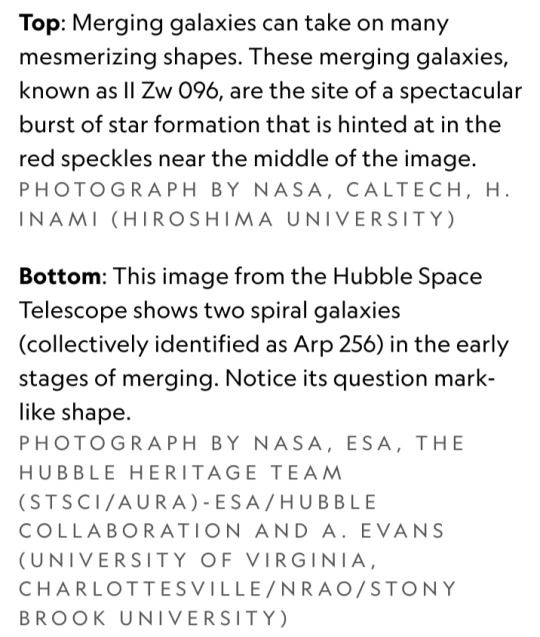
The red of the question mark could mean it’s very far away (light waves stretch as they travel through the expanding universe, shifting to redder wavelengths) or that it’s closer and obscured by dust near the object.
It would take more investigation to identify exactly how far away the question mark is.
This could be done by measuring photometric redshifts, determined by the brightness observed through different filters, but this would only provide an estimate for the distance, Britt says.
Spectroscopy, which analyzes light from the source to determine its elemental makeup, could provide a more exact distance but requires a separate instrument to measure.
Given the number of intriguing targets spotted by JWST, the question mark may never receive this treatment.
For now, the source of this symbol in the sky remains a cosmic mystery.
#James Webb Space Telescope (JWST)#celestial question mark#stars#galaxy#space#astronomy#Herbig-Haro 46/47#NIRCam#infrared light#protostars#Christopher Britt#Space Telescope Science Institute#galactic nuclei#astronomers#Hubble Space Telescope#photometric redshifts#Spectroscopy#cosmic mystery#National Geographic#Nat Geo#NASA
9 notes
·
View notes
Text

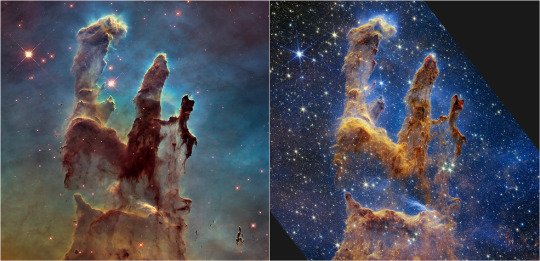
Webb telescope shows the Pillars of Creation in near-infrared (top, and right). Visible light image from Hubble made in 2014 on the left. The red glowing points are newly-formed stars.
#webb space telescope#nircam#space!#science!#nasa#eagle nebula#pillars of creation#hubble#my beloved#breathtaking
50 notes
·
View notes
Photo

Y’ALL. @nasawebb did it again. Fresh photons for your eyeballs: the Pillars of Creation! From the #Webb Telescope website: “NASA's Hubble Space Telescope made the Pillars of Creation famous with its first image in 1995, but revisited the scene in 2014 to reveal a sharper, wider view in visible light, shown above at left. A new, near-infrared-light view from NASA’s James Webb Space Telescope, at right, helps us peer through more of the dust in this star-forming region. The thick, dusty brown pillars are no longer as opaque and many more red stars that are still forming come into view. While the pillars of gas and dust seem darker and less penetrable in Hubble’s view, they appear more diaphanous in Webb’s.” See the full res images at WebbTelescope.org!! #JWST #wowzers #nebulae #NIRCam #UnfoldTheUniverse https://www.instagram.com/p/Cj5iuH-ucGC/?igshid=NGJjMDIxMWI=
42 notes
·
View notes
Text
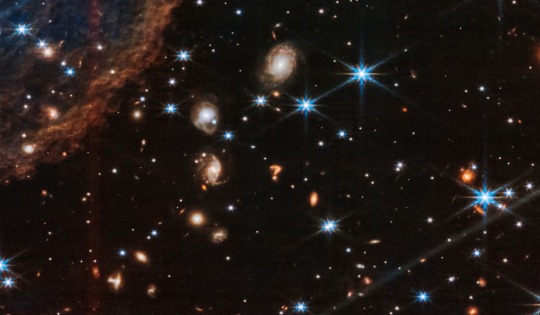
This glowing red question mark was captured in the background of a new image from the James Webb Space Telescope. Photograph By NASA, ESA, CSA
NASA Just Found a Question Mark in Space. What Exactly is It?
The object is far outside our galactic neighborhood, possibly billions of light-years away. But astronomers have seen similar objects closer to home.
— By Allie Yang | August 9, 2023
Two of our galaxy’s most famous stars were recently photobombed by what appears to be a celestial question mark.
The symbol was spotted in a new image from the James Webb Space Telescope (JWST) of the forming stars Herbig-Haro 46/47, which are well-known and have been frequently observed by astronomers. These two stars can provide clues about how our own sun may have formed. They’re relatively close to Earth, about 1,400 light-years, and relatively young, only a few thousand years old. In fact, they’re still in gestation and have not technically been “born” yet, which is marked when the stars start shining from their own nuclear fusion.
The image is the first of the twin protostars from the NIRCam instrument on JWST. It was captured using infrared light, which penetrates space dust more easily than visual light, and it is the highest resolution image of the objects ever seen at these wavelengths.
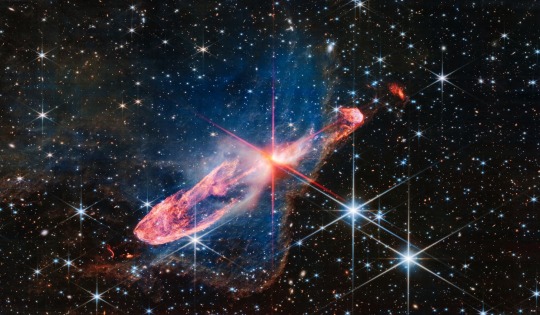
The two protostars are buried deep in the gas and dust that are being drawn in to add to their mass—look for them at the center of the red diffraction spikes. These stars are only a few thousand years old, and stars take millions of years to fully form. Photograph By NASA, ESA, CSA
The telescope’s astonishing sensitivity allowed the glowing red question mark to be captured in the lower center of the image. The object is far outside our galactic neighborhood, possibly billions of light-years away, says Christopher Britt, an education and outreach scientist at the Space Telescope Science Institute who helped plan these observations.
His best guess is that the question mark is actually two galaxies merging.
“That's something that's seen fairly frequently, and it happens to galaxies many times over the course of their lives,” he says. “That includes our own galaxy, the Milky Way … [it] will merge with Andromeda in about four billion years or so.”
The hints pointing to two galaxies are found in the question mark’s strange shape. There are two brighter spots, one in the curve and the other in the dot, which could be the galactic nuclei, or the centers of the galaxies, Britt says. The curve of the question mark might be the “tails” being stripped off as the two galaxies spiral toward each other.
“It's very cute. It's a question mark … But you can find the colons and semicolons, and any other punctuation mark, because you have 10,000 little smudges of light in each image taken every half hour,” says David Helfand, an astronomer at Columbia University. The sheer number of shining objects we find are bound to create some serendipitous images, and our brains have evolved to find those patterns, he says.
Astronomers have seen similar objects closer to home. Two merging galaxies captured by the Hubble Space Telescope in 2008 also look like a question mark, just turned 90 degrees.
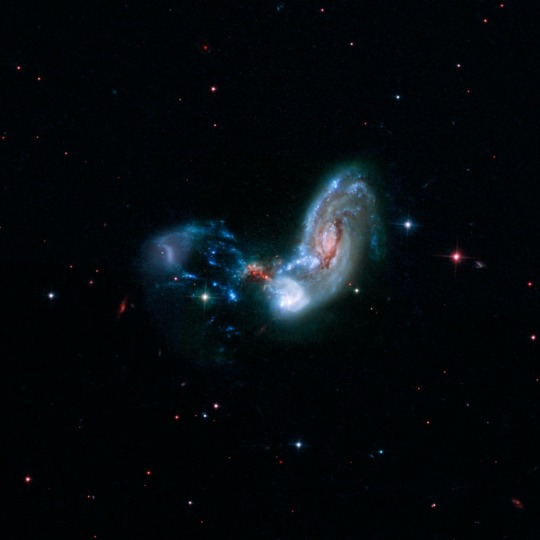
Merging galaxies can take on many mesmerizing shapes. These merging galaxies, known as II Zw 096, are the site of a spectacular burst of star formation that is hinted at in the red speckles near the middle of the image. Photograph By NASA, Caltech, H. Inami (Hiroshima University)

This image from the Hubble Space Telescope shows two spiral galaxies (Collectively Identified as Arp 256) in the early stages of merging. Notice its question mark-like shape. Photograph By NASA, ESA, The Hubble Heritage Team (STSCI/AURA)-ESA/Hubble Collaboration and A. Evans (University of Virginia, Charlottsville/NRAO/Stony Brook University)
Helfand says the question mark seems to be two objects, the curve and the dot, but could be more that just happened to line up. They could also be completely unrelated objects, he says, if one is much closer to Earth than the other.
Britt warns that estimating distance based only on colors in the image can be tricky. The red of the question mark could mean it’s very far away (light waves stretch as they travel through the expanding universe, shifting to redder wavelengths) or that it’s closer and obscured by dust near the object.
It would take more investigation to identify exactly how far away the question mark is. This could be done by measuring photometric redshifts, determined by the brightness observed through different filters, but this would only provide an estimate for the distance, Britt says. Spectroscopy, which analyzes light from the source to determine its elemental makeup, could provide a more exact distance but requires a separate instrument to measure.
Given the number of intriguing targets spotted by JWST, the question mark may never receive this treatment. For now the source of this symbol in the sky remains a cosmic mystery.
#NASA#Galactic#Billions of Light-Years#Galaxy 🌌#Allie Yang#James Webb Space Telescope (JWST)#NIRCam#NASA | ESA | CSA#Space Telescope Science Institute#Christopher Britt#Hubble Space Telescope#University of Virginia#Stony Brook University#Hiroshima University
3 notes
·
View notes
Text
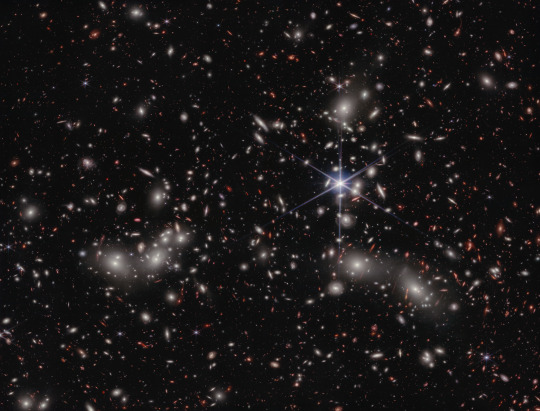
Pandora's Cluster of Galaxies
2 notes
·
View notes
Text

#space#james webb#nasa#southern ring nebula#nasa james webb space telescope#james webb space telescope#telescope#astronomy#astrophotography#space meme#james webb photos#space telescopes#space photography#space pictures#outer space#nebula#nircam#national aeronautics and space administration#cosmos#cosmology#astrophile#memes#meme#whisper memes#girlblogging#everything reminds me of her#universe#james webb deepest sharpest view of universe#james webb uzay teleskobu
17 notes
·
View notes
Text
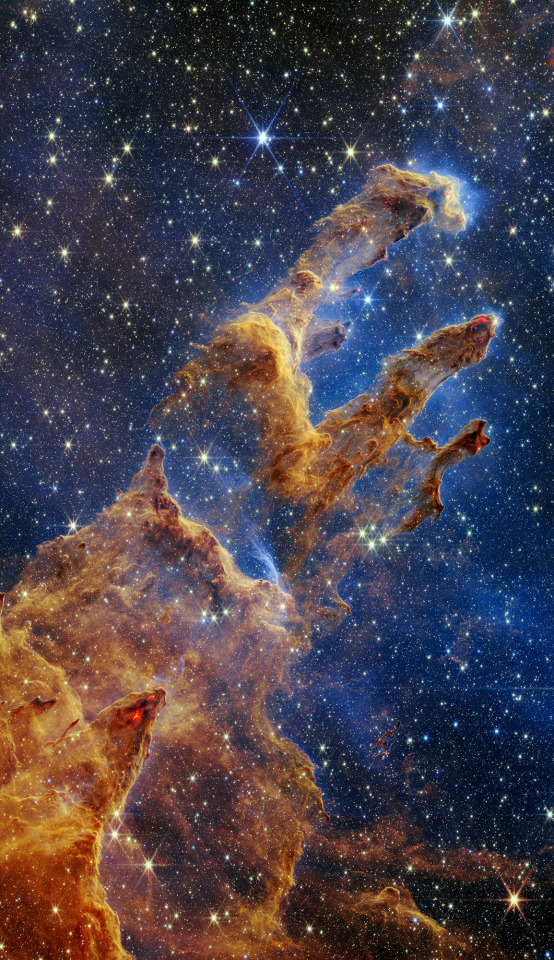
Pillars of Creation (NIRCam)
Image and Description Source
Full Res PNG 8423 X 14589 (152.33 MB)
3 notes
·
View notes
Text
Webb’s Infrared Eye Reveals the Heart of the Milky Way
Evan Gough - Webb’s Infrared Eye Reveals the Heart of the Milky Way:
#jameswebb#spacetelescope#telescope#jwst#infrared#nircam#galacticcenter#milkyway#sagittariusc#infrareddarkcloud#idc#highvelocitycompactcloud#hvcc#supernovaremnant#snr#astrophysics#infraredastronomy#astronomy
0 notes
Text
Young Stars, Stellar Jets

High-speed outflows of molecular gas from a pair of actively forming young stars shine in infrared light, revealing themselves in this NIRcam image from the James Webb Space Telescope. Cataloged as HH (Herbig-Haro) 46/47, the young stars are lodged within a dark nebula that is largely opaque when viewed in visible light. The pair lie at the center of the prominent reddish diffraction spikes in the NIRcam image. Their energetic stellar jets extend for nearly a light-year, burrowing into the dark interstellar material. A tantalizing object to explore with Webb's infrared capabilities, this young star system is relatively nearby, located only some 1,140 light-years distant in the nautical constellation Vela.
NASA
#2023#your friendly neighborhood space nerd#jwst#jwst images#constellation vela#HH (Herbig-Haro) 46/47#NIRcam
0 notes
Text

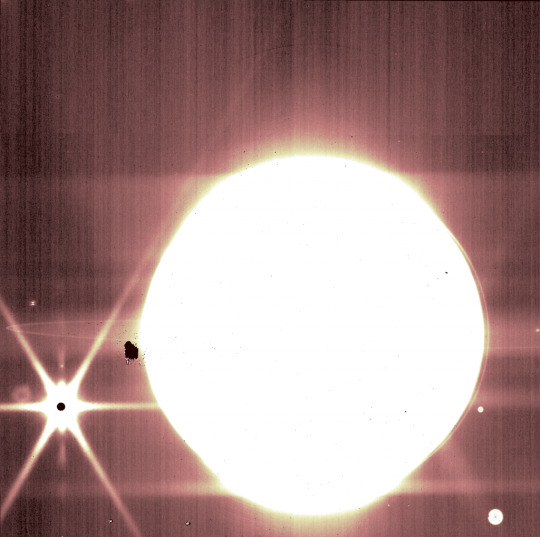

Credits: NASA, ESA, CSA, and B. Holler and J. Stansberry (STScI)
Jupiter and its moons seen through JWST's NIRCam's various micron filters.
#nasa#space#astronomy#science#astrophotography#physics#jwst#astrophysics#james webb space telescope#jupiter#europa#moon#moons#planet#solar system#nircam#thebe#metis#cosmos#my post#planets#rename jwst#RenameJWST
156 notes
·
View notes
Text
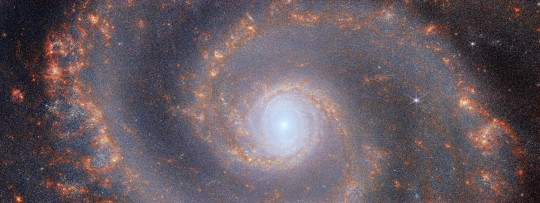


m51
6 notes
·
View notes
Photo

Çubuklu sarmal gökada NGC 5068'in James Webb Uzay Teleskobu'nun NIRCam aygıtından alınan bu görüntüsü, gökadanın parlak merkezi çubuğu boyunca en yoğun olan devasa yıldız popülasyonu ve içindeki genç yıldızlar tarafından aydınlatılan yanan kırmızı gaz bulutları ile süslenmiştir. Galaksinin bu yakın-kızılötesi görüntüsü, NGC 5068'in çekirdeğini oluşturan yaşlı yıldızların muazzam bir şekilde bir araya gelmesiyle doldurulmuştur. NIRCam'in keskin görüşü, astronomların galaksinin gazını ve tozunu dikkatle inceleyerek yıldızlarını yakından incelemesini sağlar. Yoğun ve parlak toz bulutları, sarmal kolların yolu boyunca uzanır: Bunlar, yeni yıldızların oluştuğu hidrojen gazı toplulukları olan H II bölgeleridir. Genç, enerjik yıldızlar etraflarındaki hidrojeni iyonlaştırarak kırmızıyla temsil edilen bu ışıltıyı yaratıyor.Kredi: ESA/Webb, NASA & CSA, J. Lee ve PHANGS-JWST Ekibi
#James Webb Uzay Teleskobu#NGC 5068#NIRCam#ESA/Webb#NASA & CSA#J. Lee ve PHANGS-JWST Ekibi#teşekkürler#H II
1 note
·
View note